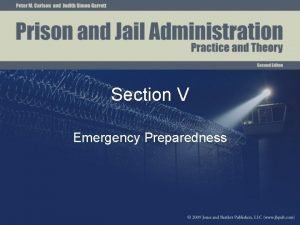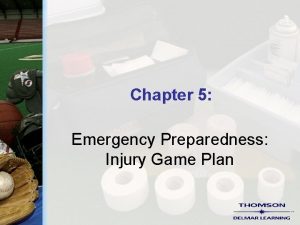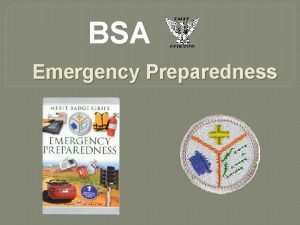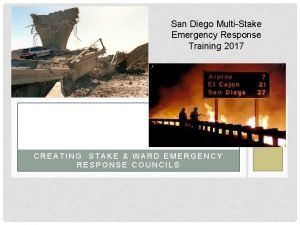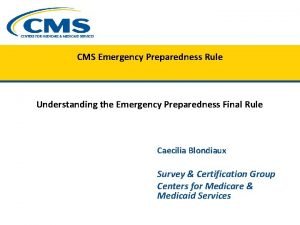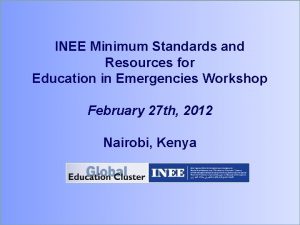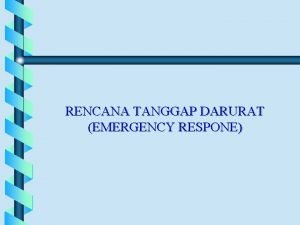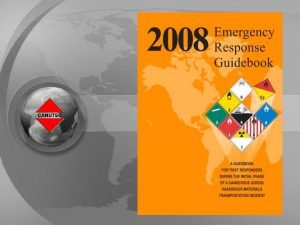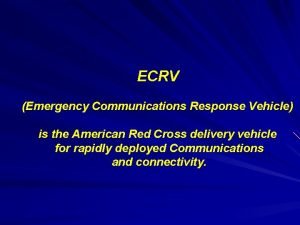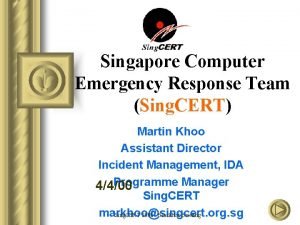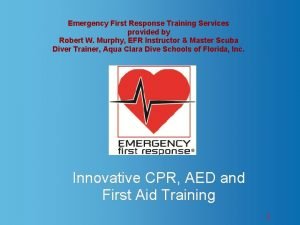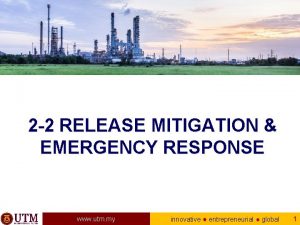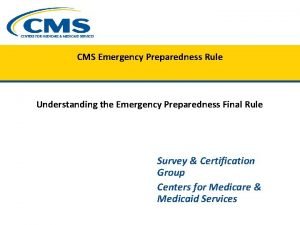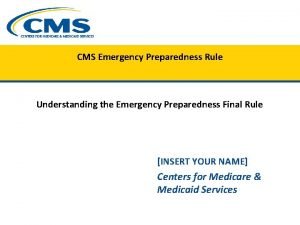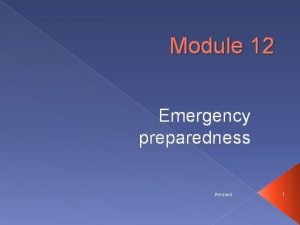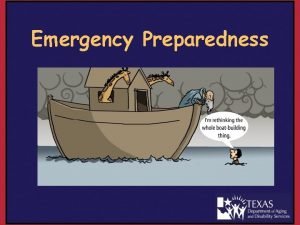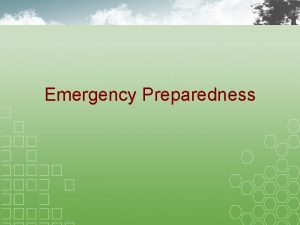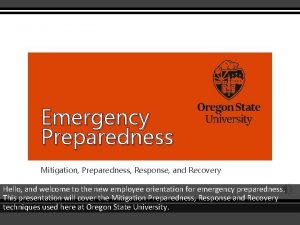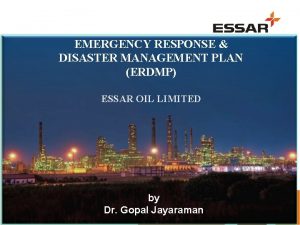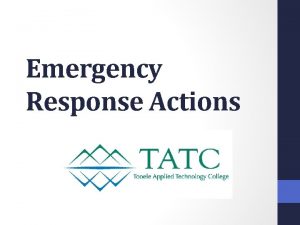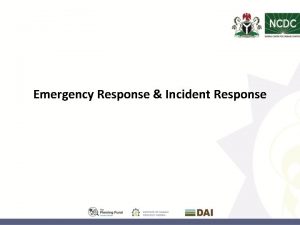Emergency Preparedness and Response Understanding Key Elements and














- Slides: 14

Emergency Preparedness and Response: Understanding Key Elements and Your Role New Hire Orientation Prepared by: New York City Department of Health and Mental Hygiene’s Office of Emergency Preparedness and Response (OEPR)

Objectives Outline 1. 2. 3. 4. NYC DOHMH’s role in an emergency Overview of OEPR’s key functions Emergency notification process Personal preparedness

Types of Potential Emergencies: CBERN Chemical • Carbon Monoxide Poisoning • Chlorine Poisoning • Sarin Gas Biological • Smallpox • Pandemic Flu (H 1 N 1) • Anthrax • Salmonella Infection Explosive • Pipe Bomb • Improvised Explosive Device or accidental explosion of industrial or agricultural materials • Dynamite Radiological/Nuclear • Dirty Bomb • Accidental release from medical or industrial device Natural • Extreme heat • Coastal storms • Snowstorms • Earthquakes

Past NYC DOHMH Responses 1999: West Nile Virus 2001: 9/11 and Anthrax letters 2003: Northeast Blackout 2004: Republican National Convention radiological incident 2005: Transit Strike 2006: Inhalational Anthrax: African Drummer 2007: Steam Pipe Explosion and Deutsche Bank Fire 2008: West Village Hepatitis A Exposure Spring 2009: H 1 N 1 Response Fall 2009: Fall Vaccination Campaign 2011: Hurricane Irene 2012: Hurricane Sandy

DOHMH Roles in Emergencies • Identify diseases and potential risk levels of certain • Provide guidance to the healthcare community • • • Distribute medication to the public Provide safety information to the public and • • • populations regarding disease identification and treatment Provide emergency information to the public emergency workers regarding potential hazards in different environments Coordinate mental health needs and services Provide staff for emergency evacuation centers and potential hurricane shelters Continually provide critical agency services

OEPR’s Key Functions and Management Cycle PLAN EVALUATE TRAIN EXERCISE

DOHMH’s Incident Command System (ICS) • Incident Command System (ICS) is a standardized organizational structure used nationally by first response agencies, in situations when the existing organizational structure becomes overwhelmed (i. e. , during emergencies). • The DOHMH ICS: – Delineates roles by ICS title and experience, not day-to-day responsibilities (*This means you may have a different assignment and supervisor during an emergency) – Provides management tools to efficiently organize staff into clearly defined roles – Facilitates clear communication by eliminating radio codes, slang and jargon – Ensures safety of staff – Leverages the agency’s resources effectively

Understanding Continuity of Operations (COOP) • Continuity of Operations (COOP) ensures the ability of an agency to continue its essential services during a wide rage of emergencies. • Examples of essential services include: - Correctional Health Services - Death and Birth Certificate Issuance - Poison Control Center

Emergency Role Expectations • Responding to emergencies is a key part of DOMHM’s mission and role in the city • All DOHMH employees are expected to participate in • emergency response if directed Staff may: - Work from a different location than usual - Work different and/or longer hours than usual - Perform tasks different from day-to-day work - Report to a supervisor different from your day-to-day supervisor

Other Assignments: Points of Dispensing (PODs) • Points of Dispensing (PODs): sites opened when the emergency requires the mass distribution of vaccine or medication to the public - POD Core Team Staff (leadership) • Set up and manage PODs • Make assignments for the General Staff • Attend training and exercises to practice - General Staff • Have a POD assignment with direct public contact • Receive assignments and training at the POD

Other Assignments: Citywide Emergency List (CWL) • Citywide Emergency List (CWL): made up of personnel from New York City agencies who may be called upon to work on citywide emergency operations 1. Hurricane shelters 2. Evacuation Centers (usually in employee’s home borough) • Examples of CWL positions: 1. Operator 2. Specialist 3. General Staff

Get Prepared • Review your emergency role • Train for your assignment • Develop a Family Preparedness Plan • Have a Go Bag • Visit NYC OEM’s website for additional information and preparedness plans

Thank You! OEPR looks forward to working with you in preparation for our next emergency.

Questions? Contact: Thomas Mauro Director of Exercises and Training tmauro 1@health. nyc. gov 347 -396 -2746 Rebecca Baron Training Coordinator rbaron 1@health. nyc. gov 347 -396 -2773
 Chapter 36 emergency preparedness and protective practices
Chapter 36 emergency preparedness and protective practices Chapter 36 emergency preparedness and protective practices
Chapter 36 emergency preparedness and protective practices Chapter 5 emergency preparedness injury game plan
Chapter 5 emergency preparedness injury game plan Bsa emergency preparedness
Bsa emergency preparedness National radiological emergency preparedness conference
National radiological emergency preparedness conference Stake emergency preparedness plan
Stake emergency preparedness plan Cms emergency preparedness final rule
Cms emergency preparedness final rule Preparedness mitigation response recovery
Preparedness mitigation response recovery Rencana tanggap darurat
Rencana tanggap darurat Orange section erg
Orange section erg Ercp emergency response
Ercp emergency response Ecrv
Ecrv Singapore computer emergency response team
Singapore computer emergency response team Emergency response training services
Emergency response training services Utm emergency response plan
Utm emergency response plan

